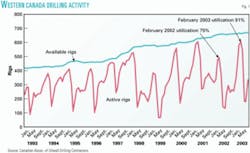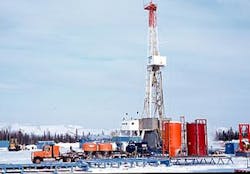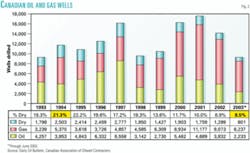Canadian drilling rates are strong and the well success rate has continually improved over the past decade. Canada's gas production has increased almost every year, despite bigger decline rates. Light oil production is declining, but heavy oil production is increasing. And weak oil and gas prices from mid-2001 to mid-2002 resulted in reduced drilling and investment from the highs of early 2001. Stronger prices since mid-2002 have led a resurgence in drilling.
Western Canada
The focus of activity this year is in the Western Canada Sedimentary basin (WCSB), covering 580,000 sq miles and underlying four Canadian provinces and the Northwest and Yukon Territories. Rig activity plummeted from a high of 607 rigs working in February 2003 to a low of 98 working during the week of May 13, 2003 (Canadian Association of Oilwell Drilling Contractors, CAODC, data).
Rig utilization in western Canada reached a peak of 91% in February 2003; an improvement over the 75% utilization rate in February 2002, and nearly on par with the 97% utilization rate in February 2001 (Fig. 1). The number of rigs in the region increased by 2% in the past year, to 670 rigs as of August 2003. In the past 5 years, the rig count was expanding more rapidly, at 4-5%/year.
null
Alberta produces 70% of Canada's crude oil and 80% of its natural gas and leads the other western provinces in number of active rigs, from a low of 68 rigs to a high of 423 rigs (week of Jan. 28).
Saskatchewan produces nearly 20% of Canada's crude oil, but gas well drilling is increasing, while oil well drilling is decreasing. Drilling activity ranged from 6 to 65 rigs (May 2003).
British Columbia produces 13% of Canada's natural gas, with most of the rigs drilling for gas. Recent discoveries are sure to increase activity. The newly discovered (2002) Greater Sierra gas field in northeast British Columbia contains an estimated 5 tcf of gas. The Ladyfern Slave Point gas field, discovered by Apache Canada in winter 2000, contains estimated recoverable reserves of 700 bcf to 1 tcf of gas.
There was a low of 8 and a high of 137 rigs (February) drilling in British Columbia in the past 12 months.
Manitoba hosted the lightest drilling activity over the past year. Up to 2 rigs were drilling concurrently for oil; none targeted gas.
There was minor drilling activity in Northwest Territories (up to 14 active rigs), focused on the Mackenzie-Liard Valley area, a northern extension of the WCSB.
Cyclical activity
The western Canadian oil and gas industry operates in seasonal cycles, with most drilling in the fall and winter, peaking in February, and dropping off rapidly in spring.
Ziff Energy Group, Calgary, released the Western Canadian Drilling Optimization Study on June 24, 2003. This joint industry effort was sponsored by the Canadian Association of Geophysical Contractors (CAGC), CAODC, Canadian Association of Petroleum Producers (CAPP), Petroleum Services Association of Canada (PSAC), and the Alberta and BC governments.
The study cites peak utilization rates of nearly 90% but an annual utilization rate of just 53%. It attempts to build a business case for spreading drilling throughout the year.
"During slow periods the drilling cycle has a tremendous impact on the industry's labor pool as a large part of the workforce is laid off due to the lack of activity," says Bill Gwozd, vice-president for gas services, Ziff Energy Group.
"Many quality people leave the industry as they move to industries with more stable employment opportunities. Safety is also impacted as a direct result of the industry's inability to keep experienced workers. Every year in the fall and winter, when activity picks up, vast numbers of new employees are required to fill the demand, many of them new to the industry and inexperienced."
Mergers, buyouts
Husky Energy Inc. announced on Aug. 20 that it agreed to acquire all shares of Marathon Canada Ltd. and the Western Canadian assets of Marathon International Petroleum Canada Ltd. for $588 million; the sale will close in fourth-quarter 2003. Marathon retains exploration interests in eastern Canada.
On Aug. 6, APF Energy Inc. announced its agreement to acquire CanScot Resources Ltd. for $34.9 million; this will close in mid-September.
Dan Allan, president and CEO of CanScot states "The financial strength of APF Energy, combined with their commitment to aggressively develop our large coalbed methane [CBM] reserves in both Canada and the US should contribute significantly to their exceptional growth.U
"The potential for CBM development in Canada may be significant. CBM production in the US is a very significant energy source, accounting for close to 10% of its natural gas production. I believe that Canada is at the very early stages of its CBM development."
Blue Mountain Energy Ltd. acquired Bolt Energy Ltd. in September 2002 (15 wells drilled in Alberta and Saskatchewan in 2003).
Onshore, eastern Canada
Dan McFadyen, deputy minister of energy for Nova Scotia, said in a midyear presentation to the Canadian Bar Association's Natural Resources and Energy Law Section (Nova Scotia Branch) that "five different companies will be active onshore Nova Scotia this year with work that could involve three seismic programs and four to five wells."
Through joint ventures, Contact Exploration Inc., Calgary, plans to drill a minimum of three wells on its East Coast onshore acreage during 2003. Contact and joint venture partner Vintage Petroleum Canada Inc. (Canadian subsidiary of Vintage Petroleum, Tulsa) commenced drilling the Beach Hill No. 1 well, onshore Nova Scotia, on July 21, 2003, drilled to a depth of 1,044 m, and declared it abandoned in August 2003.
Another joint venture onshore Nova Scotia, between Contact and Oiltec Resources Ltd., will include a drilling program about 20 km east of Windsor; it had a tentative start date of mid-August, depending on rig availability.
Industry progress in New Bruns- wick, Prince Edward Island, and Newfoundland has caused this renewed interest in onshore Nova Scotia. Petroleum exploration began in Nova Scotia in the 1860s, and the first oil well, the P-1, was spud in summer 1869.
Offshore, eastern Canada
Two jack ups and three semi's were contracted in Canadian waters as of mid-year 2003, representing 100% utilization of those fleets (ODS-PetroData). The two main areas of drilling activity include: the Scotian shelf, off southern Nova Scotia, and the Grand Banks off Newfoundland (Jeanne d'Arc basin).
McFadyen said that "there could be as many as 8-10 exploration wells drilled in the next 12-18 months. This would be more wells than have been drilled offshore Nova Scotia in the past decade." He added that "we could see a total of more than 2 dozen exploration wells drilled before the exploration licenses expire [at] the end of 2006."
In the Scotian basin and shelf, 110 exploration wells have already been drilled. Last year, 5 wells were drilled off the east coast of Nova Scotia, including the first 3 modern-era deepwater wells: Marathon drilled on the Annapolis Block (1,700 m), Chevron (in partnership with Petro-Canada) drilled on the adjacent block, and EnCana Corp. (was AEC) drilled on the Torbrook Block, using the Eirik Raude semisubmersible platform that was recently completed in Halifax. EnCana's EL-2384 was abandoned on Jan. 9, 2003. Marathon plans to spud the next well on the Annapolis Block in 2004.
The other two wells off Nova Scotia were drilled by Canadian Superior Energy Inc. (in partnership with El Paso Oil & Gas Canada) on the Marquis Block with the Rowan Gorilla V, and by Shell Canada Ltd. on the Onondega Block (B-84).
The Shell B-84 was not tested, and Ray Woods, resources senior operating officer, Shell Canada, said "We are disappointed that the well did not reach total depth and did not confirm a larger natural gas accumulation in the deeper section, which may have supported an expansion of existing infrastructure. However, the reserves confirmed by this well will contribute to maintaining longer-term gas production from the basin."
Development drilling continues off Newfoundland. Hibernia Management & Development Co. Ltd. (HMDC) has spud three wells from the Hibernia platform since December 2002 to projected depths of 7,258 m. The PetroCanada Terra Nova Alliance has spud two wells from the Henry Goodrich semisubmersible since September 2002 to projected depths of 4,641 m.
Offshore, western Canada
Although the moratorium on exploration off western Canada has been in place since 1972, the Canadian federal government announced in March that a panel will study the impact of allowing drilling around the Queen Charlotte Islands.
A report is expected in early 2004. British Columbia's provincial government is pushing for renewed activity; its Division of Oil & Gas is working with the federal government to determine control of the BC seabed.
The Queen Charlotte (QC) basin occupies the continental shelf east of the QC Islands and is the largest Tertiary basin off western Canada. Only 17 exploration wells have been drilled on the QC Islands and adjacent offshore, the most recent by Shell Canada Ltd., in 1965-69. Several had Tertiary shows. Seismic was run in the late 1980s. Government-initiated, integrated geoscience studies of the QC basin estimate total recoverable resources of 2.6 billion bbl oil and 20 tcf gas from the Tertiary section alone.1 The underlying Mesozoic section is also considered prospective.
Additional basins off western Canada include the Georgia basin (on the shelf east of Vancouver Island), and Tofino and Winona basins (on the continental shelf and slope west of Vancouver Island). British Columbia's energy minister, Richard Neufeld, estimated that there is up to 42 tcf gas and 10 billion bbl oil in place throughout the western offshore basins.
Diminishing dry holes
The drilling success rate in Canada has steadily increased over the past decade, from a 21.3% dry-hole rate in 1994, to an 8.5% dry-hole rate through the first half of 2003 (Fig. 2). This can be attributed to an increase in infill drilling, drilling out shallow pools, and use of increasingly sophisticated technology.
Canada is the third largest producer of natural gas and the fourteenth largest producer of crude oil in the world.2 It has a large potential of untapped offshore oil and gas deposits, coalbed methane, and tight gas, particularly in the WCSB.
References
1.Hannigan, P.K., Dietrich, J.R., Lee, P.J., and Osadek, K.G., Petroleum resource potential of sedimentary basins on the Pacific margin of Canada, Geol. Surv. Canada Open File 3629, 1998, 85 pp.
2. Canadian Association of Petroleum Producers (CAPP): www.capp.ca.




